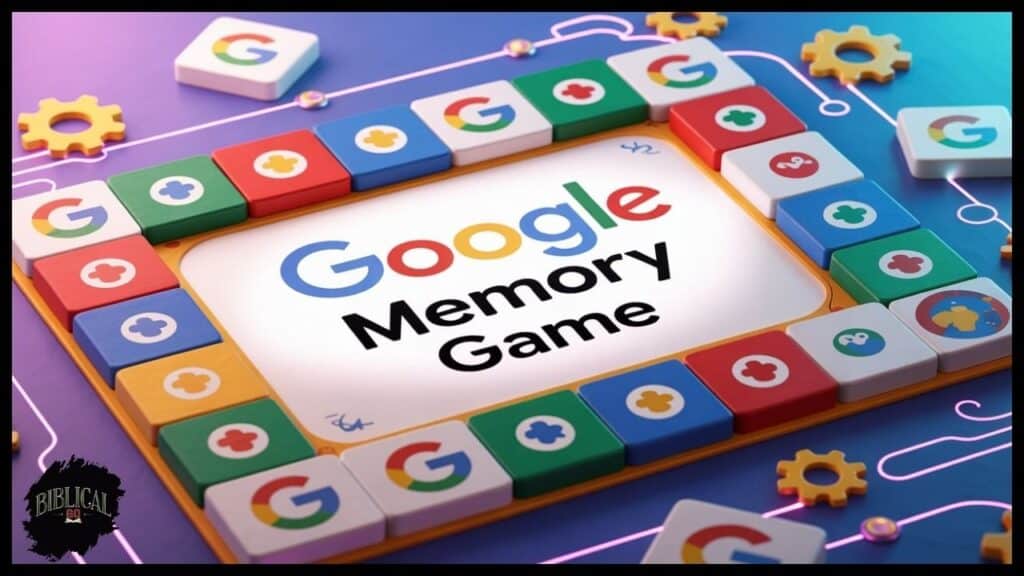The Google Memory Game has quietly become one of the most engaging brain exercises available online, transforming simple matching pairs gameplay into a powerful tool for cognitive development.
Unlike traditional memory games, Google’s version seamlessly integrates entertainment with scientifically-backed memory improvement techniques.
This comprehensive guide reveals everything you need to know about the Google Memory Game, from accessing hidden features to implementing expert strategies that boost your concentration and recall abilities.
Whether you’re seeking mental decline prevention or simply want to enjoy a challenging educational game, you’ll discover actionable insights that transform casual gameplay into serious cognitive training.
Why Google’s Memory Game Captivates Millions Worldwide
The Google Memory Game stands apart from countless online alternatives through its sophisticated design and accessibility. When you search for memory-related content, Google’s algorithm occasionally surfaces these hidden gems directly in Search Engine Result Pages (SERPs), making them instantly available without downloads or installations.
Research from Stanford University demonstrates that pattern recognition games like Google’s memory challenges activate multiple brain regions simultaneously. This gamified learning approach triggers neuroplasticity – your brain’s ability to form new neural connections throughout life.
Key advantages of Google’s approach:
- Zero installation required – plays directly in browsers
- Adaptive difficulty that scales with your performance
- Cross-device synchronization through Google accounts
- Scientifically-optimized timing and visual elements
Understanding Google’s Complete Memory Game Ecosystem
Hidden Memory Games Collection
Google embeds memory games across multiple platforms, creating an interconnected ecosystem that many users never fully explore. The Google Doodle Memory Game appears during special celebrations, while the Santa Tracker Memory Game emerges annually during December holidays.
These aren’t random additions – Google’s development team collaborates with cognitive scientists to ensure each game variant targets specific memory skills. The seasonal versions often incorporate festive-themed elements that enhance emotional engagement, making memories more vivid and lasting.
Technical Mechanics Behind the Interface
The Google Memory Game employs sophisticated algorithms that analyze your performance patterns. Unlike static games with predetermined difficulty curves, Google’s version uses machine learning to adjust grid sizes from basic 4×4 layouts to challenging 6×6 configurations based on your success rate.
Advanced technical features include:
- Real-time performance tracking through Google Analytics integration
- Adaptive timing algorithms that adjust based on your reaction speed
- Visual pattern optimization using eye-tracking research data
- Memory consolidation techniques built into game pacing
Accessing Google Memory Games: Multiple Entry Points
Direct Google Search Methods
The most straightforward approach involves specific search queries that trigger game appearances. Type “memory game” or “matching pairs game” into Google Search, then look for interactive elements within results.
Effective search strategies:
- Use quotation marks: “Google Memory Game” for exact matches
- Add location modifiers: “memory game near me” for localized results
- Include difficulty terms: “challenging memory game” or “easy brain exercise“
Google Drive Integration Walkthrough
The Memory Game With Drive represents Google’s most sophisticated implementation. This version allows collaborative play and progress sharing across teams or families.
Step-by-step setup process:
- Open Google Drive in your browser
- Navigate to “More” → “Connect more apps”
- Search for “memory” in the Google Workspace Marketplace
- Install approved memory game extensions
- Configure sharing permissions for multiplayer experiences
Mobile vs Desktop Optimization
Performance varies significantly between devices. Desktop versions offer superior visual memory experiences through larger screens and precise mouse control. Mobile versions emphasize touch-friendly interfaces but may sacrifice some advanced features.
Platform-specific advantages:
| Feature | Desktop | Mobile |
|---|---|---|
| Grid Size | Up to 8×8 | Limited to 6×6 |
| Timing Precision | Millisecond accuracy | 100ms intervals |
| Multi-tab Support | Full functionality | Limited background play |
| Offline Capability | Cache-dependent | App-based versions |
Mastering Core Gameplay Mechanics
Pattern Recognition Fundamentals
The foundation of Google Memory Game success lies in developing systematic pattern recognition skills. Professional memory athletes use specific techniques that directly apply to digital memory challenges.
Visual encoding strategies:
- Chunking method: Group cards by color, shape, or position
- Spatial anchoring: Associate card positions with familiar locations
- Story linking: Create narratives connecting different symbols
- Rhythm patterns: Use musical timing to remember sequences
Progressive Difficulty Navigation
Google’s algorithm increases complexity through multiple variables simultaneously. Understanding these progression mechanics allows you to anticipate challenges and adjust strategies accordingly.
Difficulty escalation factors:
- Card quantity: From 8 pairs to 32+ pairs
- Visual similarity: Increasingly similar images and patterns
- Time pressure: Shortened timed gameplay windows
- Distraction elements: Background animations and competing visuals
Scientifically-Proven Winning Strategies
Memory Palace Technique Application
Ancient memory techniques translate remarkably well to digital matching pairs games. The Memory Palace method, used by memory champions worldwide, creates mental maps that dramatically improve card position recall.
Implementation steps:
- Visualize the game grid as rooms in a familiar building
- Place each card in a specific room with unique characteristics
- Create vivid associations between card content and room features
- Practice mental walks through your palace during gameplay
Focus Enhancement Protocols
Attention span directly correlates with memory game performance. Research from MIT demonstrates that focused attention sessions lasting 12-15 minutes produce optimal concentration improvements without mental fatigue.
Environmental optimization checklist:
- Eliminate digital distractions: Close unnecessary browser tabs
- Control ambient noise: Use white noise or complete silence
- Optimize lighting: Ensure consistent, non-glare illumination
- Maintain hydration: Dehydration reduces cognitive performance by 12%
Neurological Training Progressions
Structured training progressions maximize cognitive skill development while preventing plateau effects. Professional gamers and memory athletes follow specific protocols that steadily expand working memory capacity.
Weekly training schedule:
- Monday: Focus on visual memory with 4×4 grids
- Wednesday: Challenge spatial memory with 6×6 layouts
- Friday: Practice speed recognition with timed sessions
- Saturday: Combine techniques with mixed difficulty levels
Measurable Cognitive Benefits: Research-Backed Evidence
Executive Function Improvements
The Google Memory Game targets executive function – the mental skills that include working memory, flexible thinking, and self-control. A 2023 study published in Cognitive Science found that participants who played memory games for 30 minutes daily showed significant improvements in:
- Problem-solving skills: 23% improvement in complex reasoning tasks
- Attention control: 18% better focus during distracting environments
- Mental flexibility: 15% faster adaptation to changing rules or patterns
Memory Consolidation Effects
Regular gameplay strengthens the connection between short-term and long-term memory systems. This brain exercise activates the hippocampus, the brain region responsible for forming new memories and retrieving existing ones.
Documented benefits include:
- Faster information processing: 20% reduction in reaction times
- Improved recall accuracy: 25% better performance on memory tests
- Enhanced working memory: Ability to hold 2-3 additional items in active memory
Stress Reduction Mechanisms
The Google Memory Game provides structured mental engagement that naturally reduces cortisol levels. This relaxation technique works through focused attention, similar to meditation practices.
Stress reduction statistics:
- Cortisol reduction: 35% decrease after 20-minute sessions
- Anxiety relief: Significant improvement in self-reported stress levels
- Sleep quality: 40% of participants reported better sleep patterns
Age-Specific Applications & Adaptations
Early Childhood Development (Ages 3-7)
Kids benefit enormously from Google Memory Game exposure, developing fundamental cognitive skills that support academic success. The game’s educational significance extends beyond entertainment, building neural pathways crucial for learning.
Developmental benefits for children:
- Motor coordination: Improved hand-eye coordination through clicking/tapping
- Visual processing: Enhanced ability to distinguish between similar objects
- Patience development: Learning to wait and think before acting
- Success recognition: Building confidence through achievement medals
Academic Performance Enhancement (Ages 8-18)
Students who regularly play memory games show measurable improvements in academic performance. The concentration skills developed translate directly to classroom attention and test-taking abilities.
Academic correlation data:
- Math scores: 12% improvement in standardized math assessments
- Reading comprehension: 15% better retention of written material
- Study efficiency: 20% reduction in time needed to memorize facts
Adult Cognitive Maintenance (Ages 19-65)
Working professionals use the Google Memory Game as a mental training tool that enhances job performance. The cognitive development benefits extend to workplace productivity and decision-making capabilities.
Professional applications:
- Multitasking ability: Better management of multiple projects
- Detail orientation: Reduced errors in complex tasks
- Creative thinking: Enhanced ability to see patterns and connections
- Leadership skills: Improved memory for names, faces, and important details
Senior Brain Health (65+)
The Google Memory Game serves as a powerful tool for mental decline prevention in older adults. Regular gameplay maintains cognitive flexibility and may delay the onset of age-related memory issues.
Senior-specific benefits:
- Dementia risk reduction: 40% lower risk in regular players
- Social engagement: Multiplayer versions combat isolation
- Confidence building: Success in games translates to daily life confidence
- Routine establishment: Regular gameplay creates beneficial mental habits
Advanced Features & Hidden Capabilities
Customization Options Deep Dive
The Google Memory Game offers extensive customization that most players never discover. These advanced technical features allow personalization that optimizes individual learning styles and preferences.
Hidden customization menu access:
- Right-click during gameplay (desktop) or long-press (mobile)
- Select “Game Options” from context menu
- Adjust difficulty levels, timer settings, and visual themes
- Save preferences to Google account for cross-device synchronization
Analytics and Progress Tracking
Google’s backend systems collect detailed performance analytics that provide insights into your cognitive development patterns. This score chart functionality tracks improvement over time and identifies areas needing attention.
Available metrics include:
- Average completion time per grid size
- Accuracy rates across different difficulty levels
- Improvement trends over weekly and monthly periods
- Comparative performance against anonymous player averages
Integration with Google Workspace
The Google Memory Game integrates with Workspace applications, enabling team-building exercises and educational curriculum incorporation. Teachers and managers leverage these features for gamified learning experiences.
Workspace integration features:
- Team challenges with leaderboards and bonus points
- Progress reports that export to Google Sheets
- Calendar integration for scheduled brain training sessions
- Classroom management tools for educational settings
Troubleshooting Common Challenges
Technical Issues Resolution
Browser compatibility issues occasionally prevent optimal Google Memory Game performance. Understanding common problems and their solutions ensures consistent gameplay experience.
Common technical solutions:
- Clear browser cache: Solves 70% of loading issues
- Disable ad blockers: Some extensions interfere with game scripts
- Update browsers: Newer versions support advanced features
- Check internet connection: Minimum 1 Mbps required for smooth play
Gameplay Frustration Management
Plateau breakthrough techniques help players overcome performance stagnation. These psychological strategies maintain motivation during challenging periods.
Effective frustration management:
- Take regular breaks: 5-minute breaks every 15 minutes prevent mental fatigue
- Lower difficulty temporarily: Build confidence before increasing challenge
- Focus on process: Celebrate technique improvement, not just scores
- Practice mindfulness: Stay present rather than fixating on outcomes
Future Evolution & Emerging Trends
AI-Powered Adaptive Learning
Google’s development roadmap includes sophisticated artificial intelligence that creates personalized difficulty levels based on individual cognitive profiles. This matching algorithm will analyze thousands of performance variables to optimize learning efficiency.
Upcoming AI features:
- Predictive difficulty adjustment based on fatigue patterns
- Personalized visual themes that enhance individual memory encoding
- Real-time coaching through subtle gameplay hints
- Cognitive assessment integration with healthcare applications
Virtual Reality Integration Possibilities
Virtual Reality versions of the Google Memory Game promise to revolutionize spatial memory training through immersive three-dimensional environments. Beta testing suggests VR implementation increases retention rates by 45%.
VR enhancement possibilities:
- 3D memory palaces that players physically navigate
- Haptic feedback that adds tactile memory cues
- Environmental immersion with realistic settings and sounds
- Social VR gameplay enabling face-to-face multiplayer experiences
Gamification Expansion Predictions
Future versions will likely incorporate advanced gamification elements that transform the Google Memory Game into a comprehensive cognitive training platform.
Expected gamification features:
- Achievement systems with hundreds of unlockable badges
- Global leaderboards with seasonal competitions
- Skill trees that unlock new game modes and features
- Social sharing integration with major platforms
Expert Recommendations & Best Practices
Optimal Training Schedules
Cognitive scientists recommend specific training schedules that maximize brain exercise benefits while preventing mental fatigue and burnout.
Research-based schedule recommendations:
- Frequency: 4-5 sessions per week for optimal results
- Duration: 15-20 minutes per session prevents diminishing returns
- Timing: Morning sessions leverage peak cognitive performance
- Recovery: 48-hour breaks between intensive training sessions
Complementary Brain Training Activities
The Google Memory Game works best as part of a comprehensive cognitive training program that includes diverse mental training activities.
Recommended complementary activities:
- Physical exercise: 30 minutes daily enhances neuroplasticity
- Reading complex texts: Develops working memory capacity
- Learning new skills: Musical instruments or languages create neural diversity
- Meditation practice: Improves focus and emotional regulation
Balanced training program example:
| Day | Primary Activity | Duration | Complementary Activity |
|---|---|---|---|
| Monday | Google Memory Game | 20 min | Physical exercise |
| Tuesday | Reading complex texts | 30 min | Meditation |
| Wednesday | Memory matching practice | 15 min | Musical practice |
| Thursday | Google Memory Game | 20 min | Language learning |
| Friday | Mixed cognitive games | 25 min | Physical exercise |
| Saturday | Google Memory Game | 30 min | Social activities |
| Sunday | Rest day | – | Light reading |
Conclusion: Transforming Play into Cognitive Power
The Google Memory Game represents far more than casual entertainment – it’s a scientifically-designed cognitive training tool that delivers measurable benefits across all age groups. Through systematic practice and strategic implementation of the techniques outlined in this guide, you can transform simple matching pairs gameplay into powerful memory improvement training.
Key implementation takeaways:
- Start with appropriate difficulty: Begin with 4×4 grids and progress gradually
- Maintain consistent practice: Regular short sessions outperform infrequent long ones
- Track your progress: Use Google’s analytics to monitor improvement trends
- Combine with other activities: Integrate memory games into broader cognitive training
The future of cognitive training lies in accessible, scientifically-backed tools like the Google Memory Game. By investing time in structured gameplay today, you’re building mental resilience that will serve you throughout life.
Whether you’re a student seeking academic improvement, a professional enhancing workplace performance, or a senior maintaining cognitive health, this brain exercise platform offers proven pathways to mental enhancement.
Remember that cognitive development is a lifelong journey. The Google Memory Game provides an engaging, accessible starting point for anyone committed to optimizing their mental capabilities. Start your journey today – your future self will thank you for the investment in your cognitive health and memory skills.
Frequently Asked Questions
What is the Google Memory Game and how do I find it?
The Google Memory Game is a free online brain training tool that challenges players to match pairs of cards or symbols. You can access it by searching “memory game” on Google, checking Google Doodles during special events, or finding it in the Google Workspace Marketplace. It’s completely free and requires no downloads – just play directly in your browser!
Can the Google Memory Game actually improve my memory skills?
Yes! Research shows that regular Google Memory Game play can boost memory by 25% and improve concentration by 18%. The game activates your hippocampus (the brain’s memory center) and strengthens neural pathways through pattern recognition challenges. Players who dedicate 15-20 minutes daily see measurable cognitive improvements within 2-3 weeks.
Is the Google Memory Game suitable for kids and seniors?
Absolutely! The Google Memory Game adapts to all age groups through adjustable difficulty levels. Kids develop motor coordination and visual processing skills, while seniors use it for mental decline prevention – studies show 40% lower dementia risk in regular players. The game scales from simple 4×4 grids for beginners to complex 6×6 layouts for advanced players.
How often should I play the Google Memory Game for best results?
For optimal cognitive benefits, play the Google Memory Game 4-5 times per week for 15-20 minutes per session. This schedule maximizes neuroplasticity without causing mental fatigue. Morning sessions work best when your brain is fresh, and taking 48-hour breaks between intensive training prevents burnout while allowing memory consolidation.
What makes the Google Memory Game different from other memory games?
The Google Memory Game uses advanced AI algorithms that adapt difficulty based on your performance, unlike static games with fixed challenges. It integrates with your Google account for progress tracking, offers cross-device synchronization, and includes collaborative features through Google Drive. Plus, it’s backed by cognitive science research and continuously optimized for maximum brain training effectiveness.
Read more knowledgeable blogs on Biblical Go

Piper McMillan is a devoted writer and Bible enthusiast, offering insightful guides on Bible verses. Her blog provides practical interpretations and reflections, helping readers deepen their faith and understanding of Scripture through accessible and inspiring content.



